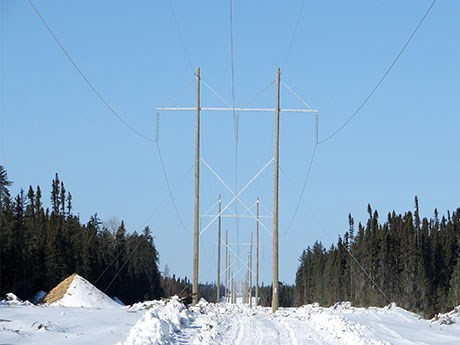Common interest speeds transmission line extension
Mining companies and First Nation communities in Northern Ontario aren’t always on opposite sides of the table haggling over impact benefit agreements and access to traditional land for exploration.
Goldcorp, which operates the Musselwhite gold mine 480 kilometres north of Thunder Bay, recently entered into a 50:50 partnership with 13 First Nations to extend and improve Ontario’s power grid in northwestern Ontario.
The new company, Wataynikaneyap Power, has a two-phase plan. Phase one involves the development of a 300-kilometre 230 kV transmission line from Ontario Power Generation’s Ear Falls hydro generating station to Pickle Lake, while phase two will focus on the extension of the grid to partnering First Nation communities currently relying on diesel power.
Goldcorp’s Musselwhite Mine gets its electricity from an existing but inadequate 115kV line to Pickle Lake and a private190-kilomtre extension of that line to the mine site.
The 115 kV line from Ear Falls to Pickle Lake “is 70 years old and the worst performing line in the province,” said Adele Faubert, the mine’s manager of aboriginal affairs. “They can’t take it offline to upgrade because it supplies three First Nation communities, the Township of Pickle Lake, as well as Musselwhite.”
Due to line losses, Musselwhite only has access to 19 kV of power and has to supplement that with four megawatts of diesel power, which “is very expensive and not very good for the environment,” said Faubert.
A new 230 kV line to Pickle Lake, which will cost between $150 and $200 million, will provide Musselwhite with additional power at significantly less cost and impact on the environment. Goldcorp will make a customer contribution, but the main component of the cost will be covered by Ontario electricity consumers through the so-called rate base.
The proposed transmission line will also improve reliability in the event of a power outage on the existing line.
Goldcorp has been pushing for the 230 kV line since 2008, but it was only early last year when the pace picked up, recalled Faubert.
“It was at a chiefs meeting and a chief from a remote community pulled me aside and said ‘I get it now. Goldcorp really is interested in working with the First Nations. My community needs this project, so let’s get it done.’”
An environmental assessment that is currently under way and that could have dragged on for years is now clear sailing.
Following the completion of the 230 kV line to Pickle Lake, Goldcorp will transfer its 50 per cent share of the partnership to its 13 partners at which point the focus will shift to the extension of transmission lines to 10 member communities currently relying on diesel power.
Several of these communities are under new construction restrictions because of a lack of generating capacity, according to Faubert.
“We had one community, for example, that wanted to open up a bakery to serve the mine site, but there wasn’t enough extra electricity in the community to hook up the ovens.”
Even more important, the extension of the provincial grid to these communities will allow them to get into the power generation business by harnessing the waterways in their traditional territories and selling the power to the grid.
Instead of spending a fortune hauling greenhouse gas emitting diesel fuel on winter roads and flying it in when the ice road season is cut short, remote First Nation communities will be able to profit from the generation and sale of clean power to the rest of the province.
According to an Ontario Power Authority (OPA) study, 25 remote First Nation communities in Northern Ontario are currently spending $68 million a year on diesel fuel. Twenty-one of the communities, it found, could be connected to the provincial grid at a cost of approximately $1 billion. The Watay Power proposal would link up 10 of them, but additional communities could choose to join the partnership.
Although Faubert is reluctant to estimate the cost of Watay Power’s phase two initiative, it’s probably somewhere between $300 and $500 million. The federal government would be expected to supplement funding from the rate base in recognition of the eventual avoided cost of diesel fuel, she speculated.
Over a period of 40 years, grid connection to the 21 remote communities would eliminate more than four million tones of greenhouse gas emissions.
Goldcorp hopes to complete the construction of the 230 kV line to Pickle Lake by 2015, while an environmental assessment for phase two of the project is expected to begin this year.
“Wataynikaneyap Power is an example of how industry and First Nations can work together on projects that are good for the economy and the environment while benefitting communities in the region for years to come,” commented Musselwhite mine manager Gil Lawson.


